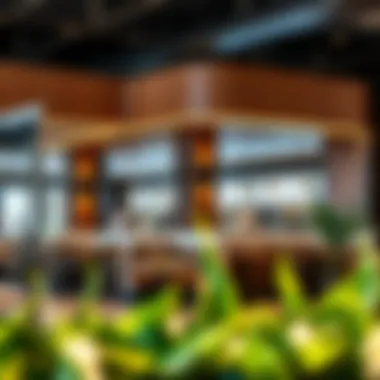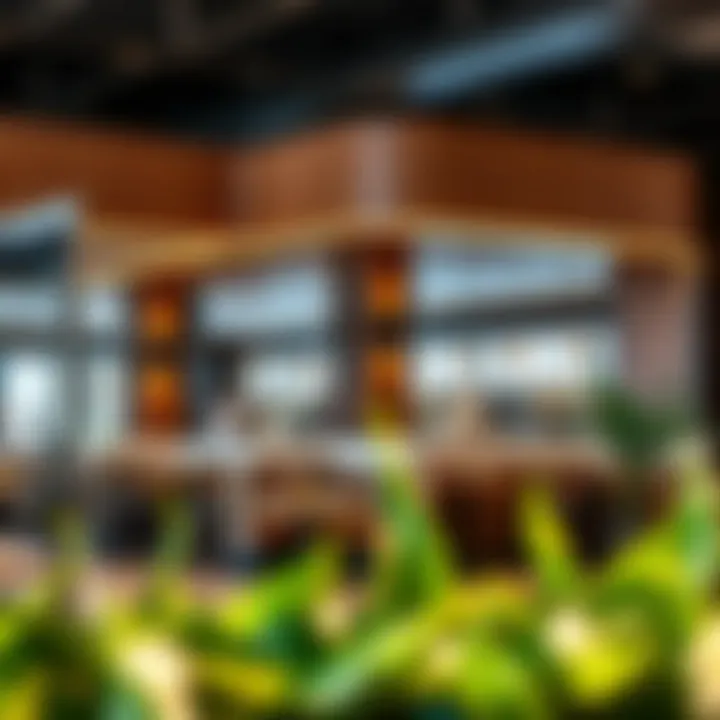Acquiring a Cafeteria in Dubai: Key Insights


Intro
Venturing into the bustling food and beverage market of Dubai is not just a business move, it’s a calculated affair requiring a blend of savvy and acumen. With the city attracting a melting pot of individuals from different backgrounds, the demand for diverse culinary experiences is at an all-time high. For investors, entrepreneurs, or anyone looking to sink their teeth into this vibrant sector, understanding the nuances involved in acquiring a cafeteria goes beyond simply finding a good location. It necessitates a keen grasp of the prevailing market dynamics and the legal frameworks at play.
When you think about buying a cafeteria in Dubai, several elements come into play. Proper vetting of market trends, property types available, and the rigorous legal requirements are paramount for making informed and strategic choices. Armed with the right information, potential buyers can navigate the complexities of this vibrant market with confidence.
In the sections that follow, we will delve into key factors shaping this industry, providing you with insights to better position yourself for success.
Market Trends and Insights
Understanding the market landscape is crucial for making sound investment choices. Analyzing current trends reveals a lot about where the market is heading and opens doors to potential opportunities.
Current Market Overview
The food and beverage sector in Dubai has been growing steadily over recent years. Cafeterias, in particular, have seen a healthy demand, catering to not just the local populace but also to the influx of tourists and expatriates looking for informal dining options. Factors such as a robust economy, high disposable income, and a cosmopolitan lifestyle contribute to this growth. As of now, there's a noticeable tilt towards health-conscious eating, with many cafes adapting menus to include organic, vegan, and gluten-free options. This evolving consumer palate is driving a need for innovation.
- Rise in demand for healthy menus
- Growth in delivery services and virtual kitchens
- Increasing investment in food tech and automation
Future Predictions and Opportunities
Looking ahead, the prospects appear promising. Analysts forecast a strong trajectory for the food service industry, with anticipated annual growth rates of 4% to 5% over the next few years. Emerging trends, like the integration of technology—think smart ordering systems and contactless payments—are set to reshape how culinary businesses operate.
Moreover, consider cities outside the main hub of Dubai. Areas experiencing rapid development and an influx of residents are prime for cafeteria opportunities. Investing in these neighborhoods not only aligns with long-term growth but taps into a burgeoning customer base craving accessible dining options.
"The shifting culinary trends and technological advancements are signaling a seismic shift in how we approach food businesses in Dubai. Innovation will be key moving forward."
Property Types and Listings
When it comes to securing a cafeteria, understanding the types of properties available is essential. Each type brings its own set of benefits and challenges, affecting both operational efficiency and customer outreach.
Commercial Real Estate Options
In Dubai, the commercial real estate market is rife with options ranging from traditional café storefronts to shared community spaces.
- Standalone Cafes: These are independent establishments, offering flexibility in branding and operations. Good for businesses aiming for high visibility and unique ambiance.
- Shared Spaces: These settings often come equipped with essential infrastructure, allowing new entrepreneurs to focus on creativity and menu development, rather than the stress of initial setup.
Gear Up for Challenges
Choosing the right property type involves diligent research. Each category presents specific zoning laws and requirements that must be adhered to. Engaging local real estate experts can save you headaches down the road.
The journey into this dynamic market requires a balance of insight and foresight. As you further explore the intricacies of acquiring a cafeteria in Dubai, the combined information and trends shall arm you with the knowledge to act decisively and strategically.
Prologue to the Cafeteria Market in Dubai
The cafeteria market in Dubai stands as a dynamic component of the city's vibrant food and beverage sector. Previously, this market was primarily seen as a simple way to grab a bite. However, shifts in culinary trends and consumer preferences have propelled cafeterias to the forefront of modern dining experiences. For anyone considering acquiring a cafeteria, understanding this evolving landscape is crucial.
Diving headfirst into this sector without a solid grasp of its underpinnings could resemble a leap into the deep end without knowing how to swim. Various factors come into play, including local tastes, competition, and even the effects of economic fluctuations. Thus, taking a closer look at the market trends and the broader food and beverage landscape becomes imperative.
This article aims to equip potential buyers and investors with the necessary insights to navigate these waters effectively. Through a combination of market overviews, trending innovations, and legal considerations, the aim is to illuminate the path for future entrepreneurs in Dubai’s cafeteria segment.
Overview of the Food and Beverage Sector
Dubai’s food and beverage sector mirrors the city’s cosmopolitan character. It is a melting pot of tastes, cultures, and traditions, attracting both locals and tourists alike. The sector has shown steady growth, fueled by an ever-increasing appetite for culinary diversity. Traditional Middle Eastern fare competes with global cuisines, from Italian to Asian, creating an eclectic dining atmosphere.
- Growing Expatriate Population: The influx of expatriates has fueled demand for diverse dining options. Cafeterias, often seen as casual dining venues, cater to varied tastes from around the world.
- Innovative Offerings: Many cafeterias are now integrating health-conscious menus, catering to the growing trend of wellness among consumers. This includes gluten-free options, vegan meals, and organic produce.
- Technological Integration: With digitization advancing, many cafes and cafeterias are embracing technology for enhanced customer experience through apps for ordering and payment.
Dubai's culinary scene is also influenced by various festivals and cultural events that celebrate food, creating short bursts of opportunities for cafeterias to thrive. Understanding these evolving dynamics is essential for anyone looking to invest in this lively sector.
Current Market Trends
Keeping an eye on current market trends is non-negotiable for aspiring cafeteria owners. The sector is undergoing rapid transformations that land opportunities but also bring inherent challenges.
- Sustainability and Eco-Friendliness: There's a palpable shift towards sustainable practices. Cafeterias are adopting eco-friendly packaging and sourcing local ingredients, tapping into a growing consumer base that values environmental responsibility.
- Rise of Delivery Services: The boom in delivery apps has altered how consumers engage with cafeterias. Establishments that adapt and offer efficient delivery services can capture a larger segment of the market.
"Adapt or perish, now as ever, is nature's inexorable imperative."


- Lifestyle Cafes: Some cafeterias are transitioning into lifestyle spaces, merging dining with experiences. The ones that provide a blend of quality food and engaging environments tend to draw in more foot traffic.
In summary, the cafeteria market in Dubai is not just about food; it’s a comprehensive experience that attracts customers who seek more than mere nourishment. The potential for acquisition is rife with prospects but requires fierce attention to market shifts and evolving consumer preferences.
Identifying Opportunities
Identifying opportunities in Dubai's cafeteria market is a pivotal step for anyone looking to invest. The bustling metropolis offers a vibrant F&B sector, which caters to a diverse clientele. The right opportunity allows for not only financial gain but also successful integration into the local culture. This section extensively outlines the specific models of cafeterias that one might consider, along with crucial aspects of choosing the ideal location.
Understanding Different Cafeteria Models
When delving into the cafeteria landscape, it's essential to know that cafeterias are not a one-size-fits-all venture. Each model comes with its unique set of characteristics and operational requirements. Here are three noteworthy models:
- Quick Service Cafeterias: Primarily targeting individuals on the go, these establishments focus on speed and convenience. They often feature a limited menu, with items that can be prepared swiftly. Understanding customer behavior is crucial in this model, as a quick turnaround often results in higher foot traffic and increased sales.
- Casual Dining Cafeterias: A notch up in terms of ambiance, casual dining cafeterias provide a more relaxed setting. With a broader menu, they aim to attract those who prefer sitting down for an enjoyable meal. Brand identity plays a significant role here, as customers often seek a comfortable environment that reflects their tastes.
- Theme-Based Cafeterias: These are establishments that capitalize on specific themes—be it cultural, culinary, or aesthetic. Such cafeterias create a unique dining experience that draws people in not just for food but for the entire experience. However, they demand a solid understanding of customer preferences and effective marketing.
Knowing the distinct models available allows investors to tailor their approach to meet specific market demands. Consider what resonates with the local culture and how to position the cafeteria within that mold.
Researching Potential Locations
Selecting the right location is akin to laying the foundation of a sturdy building. Several factors play a crucial role in determining where to set up shop:
- Foot Traffic: Areas with high foot traffic typically translate to higher visibility and increased customer potential. Locations near shopping malls, universities, or major transport hubs should be considered.
- Demographics: Understanding the surrounding population is imperative. Analyze factors such as age, income levels, and cultural preferences. A cafeteria targeted at expatriates might thrive near expatriate-friendly neighborhoods, while one focusing on local cuisine might benefit from neighborhoods with a strong Emirati presence.
- Competitor Proximity: It's wise to understand the existing competitors in the area. A bit of healthy competition can foster a vibrant market, but too many similar establishments might saturate the space, leading to diminished returns.
Incorporating tools like Google Maps and local business forums can provide firsthand insights into potential neighborhoods. Websites such as Dubai Land Department or Dubai Economy can also offer valuable data on commercial real estate trends.
"The essence of a successful cafeteria stems not only from its menu but also from its location; it is the heart and soul of the business."
Legal Considerations in Buying a Cafeteria
When contemplating the acquisition of a cafeteria in Dubai, navigating the legal landscape is not just important, it’s paramount. Legal considerations serve as the backbone of your business strategy, ensuring that you operate within the boundaries set by local laws and regulations. Failure to adhere to these legal frameworks can not only result in financial loss but also potential legal troubles that could derail your operations. Thus, understanding the legal requirements surrounding licensing and land leases is crucial for anyone looking to dive into Dubai's bustling food market.
Licensing Requirements
Securing the appropriate licenses is the first step in establishing your cafeteria. In Dubai, the Department of Economic Development (DED) plays a key role in governing the issuance of business licenses. To operate legally, you need a commercial license that caters specifically to food service. This entails a variety of documents such as proof of ownership or lease, valid identification, and, importantly, health certificates that verify compliance with food safety standards set by Dubai Municipality.
The types of licenses available can vary based on the cafeteria model you choose—ranging from a standard restaurant license to special permits for food trucks or catering services. It's worth noting that the application process can sometimes be convoluted, often requiring substantial paperwork and adherence to specific operational guidelines. To make this process smoother, consider engaging a local legal consultant familiar with the intricacies of Dubai's licensing framework. This investment can save you from administrative headaches and ensure that your cafeteria opens its doors without unnecessary delays.
Understanding the Land Lease Law
Next up, let’s talk about the land lease law. Given that most cafeterias will need a physical space, understanding the legal nuances associated with leasing is indispensable. In Dubai, the property laws can be quite unique, especially for expatriates. It’s important to grasp the distinction between freehold and leasehold properties. Freehold properties allow you full ownership, while leasehold means you’ll have a long-term lease with possibly restrictions on alterations or the term of use.
Additionally, under Dubai law, most commercial leases are governed by Law No. 26 of 2007, which outlines the rights and obligations of landlords and tenants. A solid grasp of these parameters can help you negotiate better terms and avoid issues later on. Furthermore, be vigilant about the length of the lease and renewal options—these can affect your business directly. In some cases, landlords might offer shorter-term leases under certain conditions. Also, consider including clauses regarding rent increase, as this can vary significantly depending on the market conditions.
"A comprehensive understanding of the legal environment is the bedrock upon which successful business relationships are built."
Before signing on the dotted line, you might want to include a legal expert in the discussions to ensure that all conditions are clear and fair.
Financial Aspects of Cafeteria Acquisition
When considering the acquisition of a cafeteria in Dubai, it is crucial to understand the financial landscape. This aspect serves as the backbone of the purchase process. From initial investment to ongoing expenses, the financial framework greatly affects both the operational feasibility and the potential for profitability.
Having a clear grasp of the financial dynamics allows prospective buyers to make informed decisions. It helps in budgeting adequately and offers insight into the expected returns on investment, which is particularly relevant in a competitive market like Dubai’s.
With effective financial planning, one can navigate through potential pitfalls and seize opportunities more efficiently.
Estimating Costs Involved
Estimating the costs involved in acquiring a cafeteria requires a multi-dimensional approach. You are dealing with various elements that require financial foresight:
- Initial Purchase Price: This is the sticker price of the cafeteria itself. It can vary widely based on location, size, and existing reputations.
- Renovation and Equipment: Often, a cafeteria might need a face-lift or new equipment, setting you back a pretty penny. Consider the costs of new furnishings, kitchen equipment, and decor updates.
- Licensing and Permits: Navigating through the maze of regulations typically means spending on licensing. Keep in mind that these costs can also include health and safety permits.
- Operating Expenses: These are ongoing costs that include rent, utilities, staff salaries, and inventory. Paying close attention to these expenses will ensure there are no nasty surprises down the line.
- Marketing Budget: Initial marketing strategies to attract customers can require considerable investment. Think social media ads, flyers, and local promotions.
"A stitch in time saves nine." Ensuring you have a comprehensive understanding of every cost from the onset is essential to prevent future woes.
Funding Options Available
Finding the right funding source can make or break your cafeteria venture. Here are several avenues to explore:
- Personal Savings: Tapping into your own money is often the most straightforward approach. However, this may not always be feasible for everyone.
- Bank Loans: Traditional banking routes are a common choice. Having a solid business plan in hand can significantly improve your chances of securing a loan.
- Investors: If you can present a compelling vision, you may attract private investors willing to support your startup.
- Government Grants and Programs: In Dubai, look for government initiatives aimed at promoting entrepreneurship. These can provide not just funds but also valuable resources and mentorship.
- Crowdfunding: Platforms like Kickstarter or Indiegogo can help gather financial support from the community. However, a strong marketing campaign will be necessary to make this a success.


Choosing the right funding option requires a careful assessment of your financial situation, as well as a strategy that aligns with your long-term business goals.
Operational Considerations
Operational aspects are the backbone of running a successful cafeteria. These considerations can make or break your venture, especially in a vibrant market like Dubai. Being mindful of how your operations align with strategic goals is crucial. In a city known for its fast-paced lifestyle and diverse population, your operational choices can dictate your cafeteria’s longevity and reputation. What does it take to ensure smooth sailing in your daily operations? Let’s delve into key components: staffing and management, along with supplier relationships.
Staffing and Management
One of the first hurdles to leap over is assembling the right team. Think of your staff as the face of your cafeteria, interacting directly with customers. Hiring employees who are not only skilled but also resonate with your vision is paramount. This includes baristas, chefs, servers, and even management roles. It’s important to consider that Dubai has a multicultural workforce, so you might be dealing with various communication styles and expectations.
Here are some tips for effective staffing:
- Prioritize Training: Invest in comprehensive training programs. This ensures that your team is well-versed in customer service standards, safety regulations, and food quality.
- Retention Strategies: Given the high turnover in the food service industry, create an environment where employees feel valued. Simple gestures like acknowledgment or incentives for hard work can go a long way.
- Diverse Hiring: Embrace the cultural mosaic of Dubai. A diverse team can relate better to an equally diverse customer base, enhancing customer experience.
Management practices also come into play. An efficient manager can juggle tasks from inventory oversight to employee schedules. Delegating responsibilities effectively in a fast-paced environment is key. Make use of management software to simplify daily operations, scheduling, and communication.
Supplier Relationships
The success of your cafeteria is closely linked to your relationships with suppliers. Quality of ingredients matters immensely. Whether it’s fresh produce, baked goods, or special coffee blends, having reliable sources can elevate your offerings significantly. What’s more, having a solid supplier relationship can foster trust and ensure better service.
Consider these points to build fruitful relationships with suppliers:
- Consistent Quality: When selecting suppliers, prioritize those who consistently deliver high-quality products. Request samples to evaluate whether their offerings meet your standards.
- Negotiation Skills: Don’t shy away from negotiating. Often, suppliers are open to discounts for larger orders or long-term partnerships.
- Backup Suppliers: Always have a plan B. Establish relationships with multiple suppliers for critical items. This helps maintain continuity if your primary supplier faces issues.
In brief, operational considerations can't be treated as mere afterthoughts. They are fundamental to shaping the overall experience of your customers while ensuring the smooth running of your cafeteria. Engaging the right staff and nurturing solid partnerships with suppliers are two critical undertakings that can set the stage for sustainable success.
"A successful cafeteria doesn’t thrive on good food alone; it flourishes by marrying operational excellence with customer delight."
Each of these operational facets should remain top of mind throughout your cafeteria journey. It is imperative to thoroughly evaluate and continually optimize these aspects as they contribute significantly to your overall success in this competitive landscape.
Marketing Your Cafeteria
Marketing plays a pivotal role in the success of any cafeteria in Dubai's bustling food scene. With numerous options available to residents and tourists alike, distinguishing your cafeteria becomes crucial. A well-defined marketing strategy not only attracts customers but reinforces your brand's identity, shaping the perceptions of your target audience.
A robust marketing plan should encapsulate several elements:
- Understanding Your Target Audience: Before crafting a marketing strategy, grasp who your ideal customers are. Are they busy professionals seeking a quick bite, or families wanting a comfortable dining experience? Tailor your message accordingly.
- Creating Unique Selling Points: What sets your cafeteria apart? Maybe it’s an innovative menu, local ingredients, or an exceptional ambiance. Highlighting these factors in your promotions can create a lasting impression.
- Establishing an Online Presence: In a digital world, having a strong online footprint is indispensable. A well-designed website and active social media profiles can facilitate customer engagement and increase visibility.
Additionally, consider the following benefits of an effective marketing strategy:
- Increased Foot Traffic: Engaging marketing can directly affect the number of customers walking through your doors on any given day, leading to higher sales.
- Customer Loyalty: Consistent messaging and promotional efforts foster a sense of trust among your patrons, making them more likely to return.
- Brand Recognition: An identifiable brand helps differentiate you from competitors, ensuring that customers remember you when they think of dining options.
"Effective marketing isn't just about selling; it's about creating an experience that resonates."
Building a Brand Identity
Building a brand identity is a fundamental component of any marketing effort. Your brand is essentially the personality of your cafeteria; it communicates who you are and what you stand for. In a market saturated with options, having a distinctive brand identity can make all the difference.
- Visual Elements: Your logo, color scheme, and overall aesthetic should represent your cafeteria’s character. This includes the interior decor, staff uniforms, and even menu design. Cohesiveness in visual elements can help convey professionalism.
- Storytelling: Every brand has a story. Share yours through your marketing materials and social media. Whether it’s the inspiration behind your menu or the journey to opening your cafeteria, storytelling can establish a deeper connection with your audience.
- Customer Experience: The way customers feel when they enter your cafeteria plays a huge role in brand identity. From friendly service to the environment, every touchpoint is a chance to emphasize your brand.
Investing time in building a strong brand identity lays the groundwork to cultivate customer loyalty and attract new patrons.
Leveraging Social Media and Digital Marketing
In today’s interconnected world, social media and digital marketing are indispensable tools for promoting your cafeteria. These platforms offer a cost-effective way to reach a broader audience and engage directly with potential customers.
- Engaging Content: Creating appealing content – from vibrant images of your dishes to behind-the-scenes videos – can attract attention. Share special offers or seasonal menus to entice potential diners.
- Influencer Collaborations: Partnering with local food bloggers or influencers can amplify your reach. Their endorsement can introduce your cafeteria to their followers, enhancing credibility and exposure.
- Targeted Advertising: Utilizing platforms like Facebook or Instagram allows for targeted ads, ensuring your promotions reach specific demographics likely to visit your cafeteria.
- Customer Interaction: Social media facilitates real-time interaction. Responding to comments, engaging with feedback, and providing prompt customer service can leave a positive impression.
By effectively leveraging social media and digital marketing, you can create a community around your cafeteria, foster loyalty, and ultimately drive sales.
Evaluating the Competition
In the bustling world of Dubai's food and beverage scene, understanding the competition isn’t just an option; it's a necessity. This section emphasizes the importance of deeply analyzing competitors. Knowing who they're up against and how they operate can mean the difference between thriving and merely surviving in this highly competitive market. The insights gained here help potential cafeteria owners not only to carve their niche but also to strategize effectively in a crowded space.
Evaluating competitors provides valuable information about market trends, customer preferences, and successful business models that can be emulated or improved upon. In a market as diverse as Dubai, with its colorful mix of cultures and tastes, being aware of what competitors offer is key to standing out. The benefits are clear:


- Market Insight: Grasping what competitors are doing right and wrong helps shape your own strategies.
- Target Audience Identification: Understanding who your competitors serve allows you to spot untapped market segments.
- Pricing Strategies: Analyzing competitor prices can guide your pricing to remain competitive without undervaluing your offerings.
- Product Offerings: Recognizing gaps in competitors’ menus can lead to the introduction of unique items that attract customers.
To sum it up, evaluating competition equips you with the knowledge to make informed decisions that can escalate your cafeteria from just another eatery to a celebrated dining destination.
Identifying Key Competitors
To get your feet wet in the competitive landscape of cafeterias in Dubai, the first step is identifying key competitors. The cafe and restaurant scene is not just about big names; smaller establishments often have a devoted customer base that can be just as daunting. Here are methods to pinpoint your competitors:
- Local Searches: Utilize Google and social media platforms to find cafeterias in your intended area. Key search phrases like "cafes in Dubai" or "best breakfast spots in [area name]" can yield a plethora of options.
- Review Platforms: Websites like TripAdvisor and Zomato provide insights on popular eateries based on customer feedback. These can reveal not only direct competitors but also niche players meeting specific consumer needs.
- Networking: Engage with local business owners and industry associations. Getting out there and meeting people can put you in the loop of who is doing what in the area.
- Market Research Reports: Professional publications and reports on the food industry can also provide data on major players within the market.
By identifying these key players, one can better understand the strengths and weaknesses in the market landscape, and ultimately position their cafeteria more effectively.
Analyzing Competitor Strategies
Once you know who the competition is, it's time to dive into their strategies. This analysis could uncover invaluable insights that could shape your own business decisions. Here’s what to look for:
- Menu Offerings: Take a close look at the types of food and beverages competitors offer. Are there any unique items or trends that pull in customers? Perhaps a specialty coffee or fusion dishes that could inspire your own menu.
- Pricing Models: What’s their price point? Examining whether they use wholesale suppliers or if they have custom recipes that justify their pricing can be crucial for your approach.
- Customer Experience: Observe the ambiance, service speed, and customer satisfaction levels. Not just the physical environment but how they engage with their customers online, which can illuminate effective practices and areas needing improvement.
- Promotions and Loyalty Programs: Are there ongoing promotions that seem to hit the mark? Understanding what type of marketing resonates most with the customers helps in crafting appealing offers.
"In the cafeteria business, it's not just about serving food; it's about crafting experiences that turn first-time customers into regulars."
Analyzing competitor strategies entails much more than simple watching; it necessitates keen observation and critical thought. By understanding more hours about the competition, potential cafeteria owners can refine their strategies, ultimately laying the groundwork for a successful business venture in Dubai's vibrant dining environment.
Case Studies of Successful Cafeterias
In the bustling city of Dubai, where culinary arts intersect with vibrant cultures, analyzing case studies of successful cafeterias becomes invaluable. These examples illustrate not only the potential of this business model but also the strategies that lead to fruitful outcomes. By delving into these success stories, prospective buyers can glean insights that may shape their own ventures.
Examining Local Success Stories
Focusing on local success stories is not just about celebrating achievements; it’s about understanding the specific dynamics that contribute to these triumphs in the UAE’s intricate market. For instance, a cafeteria located in Jumeirah recently gained attention for its unique blend of traditional Emirati dishes with contemporary culinary twists. This fusion approach attracted both locals and tourists, boosting foot traffic significantly.
The owners of this cafeteria capitalized on Dubai's rich heritage while introducing a modern menu that appeals to diverse palates. Unique marketing tactics, like hosting weekend cultural nights featuring local music and art, created a community hub atmosphere. This case emphasizes the importance of local flavors, community engagement, and how cultural appreciation can carve a niche in a competitive environment.
- Key Takeaways:
- Embrace local cuisine and tailor your offerings.
- Foster community connections through events.
- Create an atmosphere that resonates with your target audience.
Lessons from International Models
The global horizon offers a treasure trove of cafeteria models that have proven successful in various markets. One noteworthy example comes from Melbourne, known for its innovative food scene. A cafeteria there focused on sustainability, sourcing ingredients from local farms and adopting eco-friendly practices.
This model didn’t just enhance the cafeteria’s reputation; it attracted environmentally conscious consumers, creating a loyal customer base. By building partnerships with local suppliers, they cut costs and ensured a fresher product. The success of this model in a city known for its diverse food preferences offers a critical lesson for Dubai-based cafeterias — aligning business practices with sustainability can foster customer loyalty and brand integrity.
To summarize, understanding these international examples is essential for anyone looking to thrive in the cafeteria business. By integrating sustainability into operations and adjusting your business model to reflect your local market, you can set your cafeteria on a path toward success.
- Important Lessons:
- Consider sustainability as a core part of your business model.
- Build strong relationships with local suppliers.
- Adapt successful strategies from diverse markets to suit your target demographic.
Examining both local and international success stories not only highlights the potential for growth within Dubai's vibrant food scene but also illustrates tangible methods and strategies that can provide a competitive edge.
By analyzing these case studies, you'll find that the most successful cafeterias are those that not only meet but anticipate the evolving needs of their clientele.
Culmination and Next Steps
Navigating the realm of cafeteria acquisition in Dubai is no small feat. It’s a blend of art and science that requires keen insight and a robust strategy. This section brings to the forefront the critical elements gathered throughout this article, encapsulating valuable insights for potential investors and entrepreneurs alike who dream of setting up shop in one of the world's most dynamic food markets.
Recap of Key Considerations
When considering the journey toward acquiring a cafeteria, several key points stand out:
- Understanding your market: The food and beverage sector in Dubai is both vibrant and volatile. Observations revealed that this market thrives on trends—think about the popularity of healthy eating alternatives or the rise of gourmet street food options.
- Legal frameworks are paramount: Familiarize yourself with the licensing requirements and the land lease laws. Ignoring these can lead to complications that might derail your venture, sometimes even before it begins.
- Financial due diligence: Analyzing costs and sourcing potential funding options cannot be overstated. Knowing upfront what you're getting into monetarily will keep surprises at bay and ensure smoother sailing down the line.
- Operational strategies: It’s not merely about serving food; it's about the entire experience. Building a strong supplier relationship and maintaining a capable staff will contribute significantly to your cafeteria’s success.
In waving goodbye to these considerations, potential owners should always circle back to location flexibility and competitive awareness. It’s about staying ahead in a market that spins faster than a top on a marble floor.
Planning Your Acquisition Journey
With the groundwork laid and key considerations fresh in mind, it is time to look ahead and plan your journey meticulously.
- Draft a Business Plan: This serves as your roadmap. Outline your vision, mission, and financial projections clearly to guide your decisions.
- Scout Locations: Visit different areas and assess foot traffic, demographics, and existing competition. Observing local habits can help tailor your offerings to meet demand precisely.
- Engage Professionals: Don’t shy away from hiring a consultant and legal expert who specializes in the F&B industry in Dubai. Their expertise could save you plenty of headaches.
- Start Networking: Build relationships with suppliers, local business owners, and even customers. Venturing into community gatherings or business expos could unveil doors you never knew existed.
- Test the Waters: If possible, thriving on a food stall before jumping into a full-scale cafeteria can provide invaluable experience with lower risk.
The journey to acquiring a cafeteria in Dubai is multi-faceted, but with careful planning and strategic foresight, you can position yourself for success. For additional resources, visit Dubai Investment Development Agency, Dubai Chamber of Commerce, or browse through community insights on Reddit for up-to-date discussions.
Acquiring a cafeteria in this bustling city isn't merely a transaction; it's about embedding yourself into a culture that celebrates culinary diversity. Approach it with thorough preparation and an open mind, and the rewards can be bountiful.











